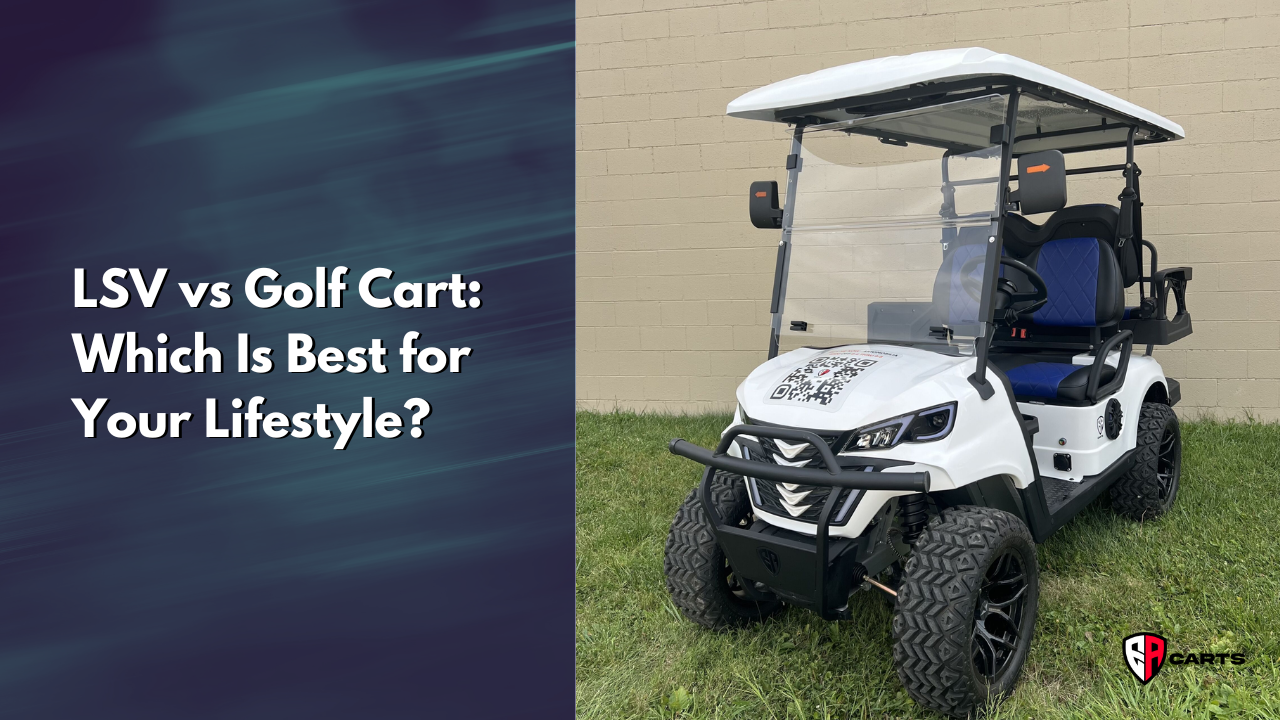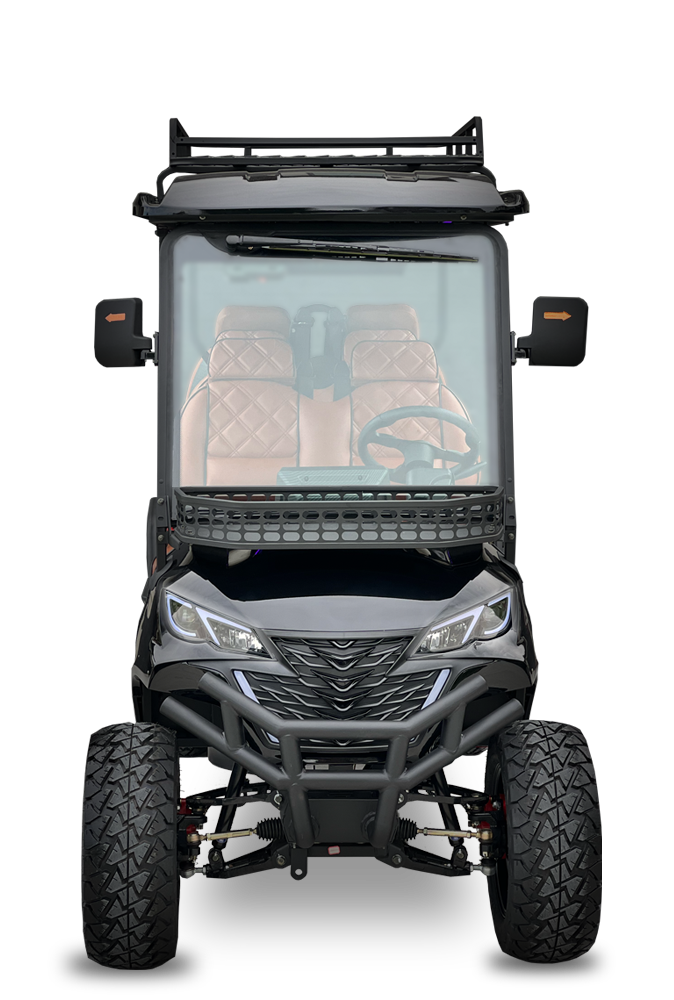Shopping for a small, personal vehicle? You’ll likely encounter the LSV vs. golf cart dilemma. Both are great for short trips, but one reigns supreme depending on your needs and location in South Carolina. This guide explains the differences regarding legality, features, and uses, simplifying your decision. Whether cruising around a neighborhood, playing golf, or running errands, understanding the LSV vs. golf cart comparison is crucial for an informed choice.
Table of Contents:
- Legality and Road Use: Golf Cart vs. LSV
- Safety and Features
- Speed and Power
- Cost and Environmental Impact
- Golf Cart vs. LSV: Practical Applications
- Converting a Golf Cart to LSV
- Real-Life Scenario: LSV vs Golf Cart
- Conclusion
Legality and Road Use: Golf Cart vs. LSV
The biggest difference between a golf cart and a low-speed vehicle (LSV) is where you can legally drive them. In most states, LSVs are street-legal on public roads with posted speed limits of 35 mph or less.
LSVs are like mini-cars, equipped with Department of Transportation (DOT)-approved features: headlights, turn signals, brake lights, reflex reflectors, and seat belts. This makes them suitable for quick trips around town. Check with your local Department of Motor Vehicles (DMV) for specific regulations and driver’s license requirements.
Golf carts are generally limited to private roads, golf courses, and designated areas. Some states permit golf carts on public roads with lower speed limits if they meet specific regulations, but this varies considerably. Always check your South Carolina Department of Transportation or your local DMV’s guidelines on golf cart usage and any registration fee requirements.
Safety and Features
LSVs are built with safety in mind, adhering to National Highway Traffic Safety Administration (NHTSA) safety standards. This makes them safer to drive on public roads alongside other motor vehicles. They come standard with everything required by the NHTSA.
While golf carts aren’t subject to the same stringent federal safety requirements, adding basic safety features is recommended. Seat belts, headlights, and taillights are smart additions regardless of where you operate the golf cart.
Speed and Power
LSVs offer a balance of speed and safety, with a maximum speed of 25 mph. This is quick enough for short commutes while maintaining lower speeds suitable for neighborhoods. A valid driver’s license is usually required to operate an LSV on public roads.
Golf carts typically have a maximum speed of 15-25 mph. However, some modified golf carts, especially newer models with lithium batteries, may be faster. It’s essential to operate a golf cart safely, whether for material handling or personal transportation, following operator safety training guidelines and being mindful of pedestrians and other vehicles.
Cost and Environmental Impact
Both LSVs and golf carts have a smaller environmental footprint than traditional vehicles. Electric models produce zero tailpipe emissions. Even gas models offer better mileage than a standard car or truck.
LSVs tend to be more expensive than golf carts due to their added safety features and street legality. The specific cost depends on the make, model, and features. Aftermarket parts support is also available for both LSVs and golf carts, as seen with accessories such as ones by MODZ. Golf cart prices are influenced by the type of battery (lithium batteries can cost more than traditional lead acid), accessories, brand and model, tire and rim types, etc.
Golf Cart vs. LSV: Practical Applications
Choosing between an LSV vs. golf cart depends on your intended use. LSVs offer practicality and street legality, suitable for short commutes and errands. Nearly half of all vehicle trips are less than 3 miles (Source), aligning with an LSV’s intended purpose.
Golf carts are ideal for golf courses, resorts, campuses, and large properties needing short-distance transportation. Their compact size, maneuverability, and lower cost suit controlled settings.
Converting a Golf Cart to LSV
Converting a golf cart to a low-speed vehicle is possible but challenging due to the NHTSA’s strict standards for LSVs.
It involves meeting specific safety regulations, including seat belts, lighting, turn signals, and more. Some required features include a rearview mirror, parking brake, odometer/speedometer, a horn, and safety glass for the windshield.
Converting can be complex and vary by state (Source). Purchasing an already-compliant LSV is often simpler and more practical. Some additional considerations are if the conversion results in a 4 wheeled vehicle, and making sure the converted cart isn’t going above the maximum speed limit.
| Feature | Golf Cart | LSV |
|---|---|---|
| Street Legal | Generally No | Yes (on roads with speed limits up to 35 mph) |
| Safety Features | Basic | DOT Approved |
| Speed | Up to 25 mph | Up to 25 mph |
| Cost | Lower | Higher |
| Typical Use | Golf courses, private properties | Short commutes, errands |
Real-Life Scenario: LSV vs Golf Cart
Consider two individuals: one lives in a retirement community, and the other near a bustling city. For the retiree, a golf cart is great for getting around their community due to the slower, controlled environment.
The city resident wants street-legal short-distance transportation for commutes, shopping, and downtown events. This situation aligns better with an LSV and its more robust capabilities. Electric vehicles, including LSVs, are gaining popularity as alternatives for short-distance travel and material handling in various settings.
Conclusion
Choosing between an LSV vs. golf cart depends on your specific situation. A golf cart is about convenience within limited areas, geared toward personal needs. An LSV prioritizes street legality, higher speed, and advanced safety equipment.
By understanding the strengths of each vehicle, you can make a clear decision perfectly suited to your needs when considering an LSV vs. a golf cart. Remember to consult your local DMV for specific requirements and restrictions related to both golf carts and LSVs in your area. Some industrial vehicles and specialty forklifts such as yard spotters and aerial lifts offer different uses for carrying equipment in work environments.





Leave A Comment